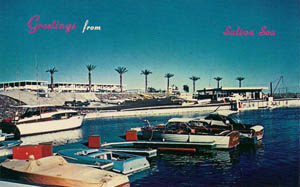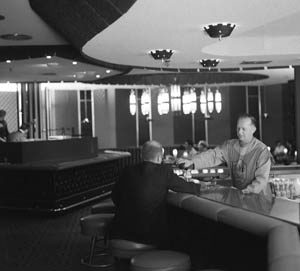Chapter 13

Long before it became the poster child for ecological calamity, this “accidental ocean,” was ringed by dozens of resort communities, and was often referred to as the Riviera of the Desert. Sinatra and the Rat Pack hung out at Salton City. Just up the road, my Grandpa Mac had a place at the Marina Mobile Estates at Desert Shores, and was even a member of the Desert Shores Yatch Club. It was there, at the Salton Sea, that I learned to ride a motorcycle, water-ski, and salt-water fish. From 1964 to 70, this was our regular, every other weekend or so, family getaway.
Chapter 14
For Southern Californians, and especially farm families like ours, the automobile was considered such an essential contrivance that it was often regarded as a part of the family unit. Evidently, the everyday conversations taking place in our house during my rug-rat days were so thoroughly interspersed with references to our 1939 Chevrolet Deluxe Coupe that my very first infantile utterance was not the usual da-da, or ma-ma, but Chevrolet—all three syllables.
Chapter 17
My father-in-law, George Bakich, was a classic example of these “New Californians” of the mid-20th century. While training as a Navy radio operator in San Diego, he developed an appreciation for California living. After the war, in answer to an ad in the Youngstown Vindicator seeking trained mechanical engineers, he moved his family to Serra Mesa California and began working for Convair Aeronautics in their new Kearney Mesa plant.
Chapter 19
The street racing habit was pervasive and persistent. Twenty years later, at the intersection of College Ave. and 54th Street, a Porsche pulled alongside my MGA and we had us a go. (Yes, my first car was an MG, so I ran in the under 100hp sports car class) The Porsche got the lead and got away; I got the ticket, and had my driver’s license suspended for six months, which at the time, was four months longer than I had it.
Chapter 20

In the Cpop era, bowling was as popular with the parents as surfing was with the kids. Nearly every community had its own space-aged Bowlarama, and nearly every mom in the neighborhood, mine included, was a member of a bowling team. Games were a bi-weekly affair and my friends and I would often tag along, not to bowl, but to be let loose amidst a surplus of opportunities for dedicated mischief makers. Our neighborhood “fun center” was University Lanes at 60th and University Ave., a 64-lane behemoth with game room, pool parlor, and the adjoining Red Coat Inn restaurant and night club. The most alluring diversion for my gang of marauding 12-year-olds was not the game room, or even the pool parlor; it was the night club. One could enter the Red Coat’s ultra-swanky night spot either through the elegant front entry way or through the massive, padded double doors off one of the bowling alley’s side corridors, which, during the morning hours when the bar was closed, were left unlocked. Set’em up Joey!
Chapter 21
In the late 60s, I use to hang out with one of the older boys in the neighborhood, a twenty-one year old Viet-Nam vet who bought and sold performance cars, which I often helped to ferry around town. Naturally, he was a very accomplished street racer, yet he rarely did the driving. Instead, he seemed to take perverse pleasure in being chauffeured around town in his own scintillatingly fast 58 Corvette by an unlicensed fifteen year old. I never really understood that; maybe he was acting out a death wish; who knows. Whatever the psychosis, I sure did love driving that vette.
Chapter 22
In my neighborhood, on any given Saturday or Sunday afternoon, you could step outside and hear the strains of a local surf band, maybe even more than one, wrestling with the intricacies of the standard repertoire. The garage door would rise, the band would play, and a very appreciative audience of neighborhood kids would gather in the driveway.
Chapter 24
My own heads-up moment came in that spring of 1971, behind the wheel of a killer 55 Chevy. I had been out of high school for eight months, and after a false start in the fall, was finally resolved to make a decent showing in college. Like most freshmen, I was focused on the future; I was not aware that Irving Gill’s futuristic “Dodge House” was torn down the year before, or that modernist maestro Richard Neutra had died. It didn’t occur to me that I hadn’t heard an exotica tune on the radio, or seen a deuce coupe, or a backyard tiki tavern, or even sat in an Eames chair outside of an airport boarding lounge in several years. As a part-timer stubbornly clinging to his longboard, I wasn’t completely aware of how far surf culture had strayed from its original construct, much less that my days as even an occasional practitioner had already ended. It wasn’t until I took custody of that killer 55 that I truely began to realize that an era had passed.
Most of the guys I hung out with drove some sort of self-modified performance car. I was one of the few exceptions. Being of a somewhat dispassionate temperament, I was never able to make the commitment necessary to maintain so demanding and spirited a ride. Instead, I settled for a series of unremarkable, foreign four-bangers—basic transport. My friend Scott, on the other hand, was a genuine true believer in the doctrine of high-performance. It was through him that I acquired most of my own first hand knowledge of, and experience with, the hot rod calling. For years, Scott drove a 1962 Chevy Nova with a mighty mouse small block built up from bolt on parts that proved to be quite a decent little runner; and then he got that killer 55.
It was one hell of a car, but certainly not in the looks department. In fact, it was a painfully ordinary looking two-tone model, white over green that had long ago faded to a flat, chalky looking petina. The chrome was dull and pitted and the interior, though still sound, had also lost its original luster. Even up close, it appeared to be just another over-the-hill hand-me-down. The veil was lifted only when the ignition key was turned hard right. After a quick tic-off of the electric fuel pump, the engine exploded to life. The sounds of the volcanic exhaust note, the rough idle, the clatter of precision machinery, and the sucking of voluminous amounts of air was absolutely disconcerting to the senses when taken together with the car’s pedestrian appearance.
It’s been so long ago that I no longer recall the engine’s size, but I’d like to think it was the big one, the 427. What I do remember is that under the hood, it was tricked out to the twelves; everything that could be done to a performance engine was done right down to the balancing and blueprinting. Gears were selected with a Hurst shifter connected to a Muncie four-speed trans. I can’t recall the rear-end specs, but I do know it was capable of maintaining traction and trajectory under hard load. To sustain the very deliberate deception, the tachometer was mounted below the dash, and the twin, four-inch exhaust cannons were mounted up into the wheel wells, just out of sight. It was a real sleeper designed specifically for street racing. On paper, an insurance company saw only an old coupe. On the road, a cop saw only an old coupe. But on the green light grand prix, guys saw only an old coupe’s tail lights. But Scott’s barnstorming days came to an end when he got his draft notice; and before he left for basic training, he asked me to look after his killer 55 while he was away.
On alternate days, I would drive the killer 55 the eleven miles from Rolando blvd. to Grossmont College and back. But I only got as far as the first stoplight before I realized I had lost my bearings. Peering out at the world over that baroque dashboard, it was as if I had gone back to a time I had yet to fully acknowledge had passed. Inside that killer 55 it was still 1963, and suddenly, the contrast between what had been, and what was, came into sharp focus. I was all alone out there. Volkswagens, Datsuns, and Saabs to my right; Volvos, Peugeots, and Fiats to my left. Where was the Scalphunter, that wicked supercharged 56 Pontiac that regularly prowled this section of El Cajon blvd? Or that flaming 406 Hi-Po Ford? Or the yellow mako-vette with the tri-power rig protruding through the hood? Or all those other go-boys we used to run with. They were nowhere to be found.
There I sat, like a rodeo rider atop a brama bull waiting for the shute door to open, firmly griping the wheel with the left hand and the shifter with the right. Motor vibration surging throughout the entire chassis, the windows rattling, the seat quivering. A whole hurricane’s worth of horsepower lay at my feet waiting to be loosed at the sudden turn of a traffic signal, and I’m sharing the pole position with a girl in a VW microbus adorned with a colorful assortment of flowered appliqués. The light turned green, and as meekly as a matron on her way to an all-day bingo bash, I proceeded along the boulevard right in step with the regular flow of traffic.
And so it was to be for rest of my tenure. Street dueling had gone out of fashion. I never did cross paths with the Scalphunter, or the flaming Ford, or the yellow mako-vette, or any of those old runners that use to haunt these very same highways. That was when I realized that what had gone before, had gone for good. So with the street racing opportunities all dried up, there was time for reflection while driving around in the killer 55. And whenever I ventured out, though the destinations might vary, the route was always the same, straight down memory lane.
In the brief interim between basic training and his deployment to Viet Nam, Scott spent his time visiting with old friends and just cruising around in his killer 55. And I wouldn’t be a bit surprised if, during those solo wanderings, he didn’t take some of the same side streets that I had frequented. Then, on the eve of his departure, he sold the killer 55. He handed over the keys and listened to it roar one last time before disappearing into a rose-colored past, token of bygone era under the golden glow of the California sun.
